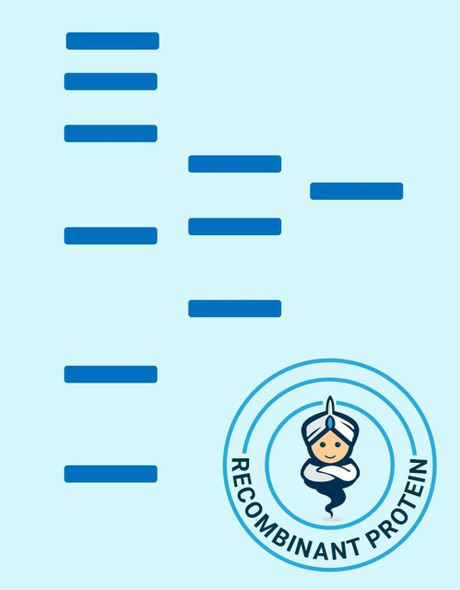Description
| Product Name: | Human HSPA1B Recombinant Protein |
| Product Code: | RPPB5242 |
| Size: | 10µg |
| Species: | Human |
| Target: | HSPA1B |
| Synonyms: | Heat shock 70kDa protein 1B, HSP70-2, HSP70-1/HSP70-2, FLJ54328, HSPA1A, heat shock 70kDa protein 1A/1B, HSPA1. |
| Source: | Escherichia Coli |
| Physical Appearance: | Filtered White lyophilized (freeze-dried) powder. |
| Formulation: | The protein was filtered (0.4�m) and lyophilized from a 0.5mg/ml solution containing 50mM phosphate buffer, 75mM NaCl, pH 7.4. |
| Solubility: | It is recommended to add deionized water to prepare a working stock solution of 0.5mg/ml and let the lyophilized pellet dissolve completely. Product is not sterile! Please filter the product by an appropriate sterile filter before using it in the cell culture. |
| Stability: | Lyophilized HSPA1B although stable at room temperature for 3 weeks, should be stored desiccated below -18°C. Upon reconstitution HSPA1B should be stored at 4°C between 2-7 days and for future use below -18°C.Please prevent freeze-thaw cycles. |
| Amino Acid Sequence: | MKHHHHHHAS AKAAAIGIDL GTTYSCVGVF QHGKVEIIAN DQGNRTTPSY VAFTDTERLI GDAAKNQVAL NPQNTVFDAK RLIGRKFGDP VVQSDMKHWP FQVINDGDKP KVQVSYKGET KAFYPEEISS MVLTKMKEIA EAYLGYPVTN AVITVPAYFN DSQRQATKDA GVIAGLNVLR IINEPTAAAI AYGLDRTGKG ERNVLIFDLG GGTFDVSILT IDDGIFEVKA TAGDTHLGGEDFDNRLVNHF VEEFKRKHKK DISQNKRAVR RLRTACERAK RTLSSSTQAS LEIDSLFEGI DFYTSITRAR FEELCSDLFR STLEPVEKAL RDAKLDKAQI HDLVLVGGST RIPKVQKLLQ DFFNGRDLNK SINPDEAVAY GAAVQAAILM GDKSENVQDL LLLDVAPLSL GLETAGGVMT ALIKRNSTIP TKQTQIFTTY SDNQPGVLIQ VYEGERAMTK DNNLLGRFEL SGIPPAPRGVPQIEVTFDID ANGILNVTAT DKSTGKANKI TITNDKGRLS KEEIERMVQE AEKYKAEDEV QRERVSAKNA LESYAFNMKS AVEDEGLKGK ISEADKKKVL DKCQEVISWL DANTLAEKDE FEHKRKELEQ VCNPIISGLY QGAGGPGPGG FGAQGPKGGS GSGPTIEEVD |
The HSP70 family is found in many intracellular compartments such as chloroplasts, endoplasmic reticulum, mitochondria, and cytosol. These proteins are induced by a variation of biological stresses, including heat stress, in every organism. HSP70 has a range of functions. For example: HSP70 acts as molecular chaperones facilitating the assembly of multi-protein complexes, HSP70 take part in the translocation of polypeptides across cell membranes and to the nucleus, and HSP70 assists in the proper folding of nascent polypeptide chains.HSP70 is a mitochondrial import equipment and has a crucial part in the cytosolic endoplasmic reticulum. Lately, extracellular localized HSP was discovered to take an important part in the induction of a cellular immune response.
The HSPA1B Protein Human produced in E.Coli is a single, non-glycosylated polypeptide chain containing 650 amino acids having a molecular mass of 71.16kDa.HSPA1B is fused to a 10 amino acids His-Tag at N-terminus and purified by proprietary chromatographic techniques.
| UniProt Protein Function: | Molecular chaperone implicated in a wide variety of cellular processes, including protection of the proteome from stress, folding and transport of newly synthesized polypeptides, activation of proteolysis of misfolded proteins and the formation and dissociation of protein complexes. Plays a pivotal role in the protein quality control system, ensuring the correct folding of proteins, the re-folding of misfolded proteins and controlling the targeting of proteins for subsequent degradation. This is achieved through cycles of ATP binding, ATP hydrolysis and ADP release, mediated by co-chaperones. The co-chaperones have been shown to not only regulate different steps of the ATPase cycle, but they also have an individual specificity such that one co-chaperone may promote folding of a substrate while another may promote degradation. The affinity for polypeptides is regulated by its nucleotide bound state. In the ATP-bound form, it has a low affinity for substrate proteins. However, upon hydrolysis of the ATP to ADP, it undergoes a conformational change that increases its affinity for substrate proteins. It goes through repeated cycles of ATP hydrolysis and nucleotide exchange, which permits cycles of substrate binding and release. The co-chaperones are of three types: J-domain co-chaperones such as HSP40s (stimulate ATPase hydrolysis by HSP70), the nucleotide exchange factors (NEF) such as BAG1/2/3 (facilitate conversion of HSP70 from the ADP-bound to the ATP-bound state thereby promoting substrate release), and the TPR domain chaperones such as HOPX and STUB1 (PubMed:24012426, PubMed:26865365, PubMed:24318877). Maintains protein homeostasis during cellular stress through two opposing mechanisms: protein refolding and degradation. Its acetylation/deacetylation state determines whether it functions in protein refolding or protein degradation by controlling the competitive binding of co-chaperones HOPX and STUB1. During the early stress response, the acetylated form binds to HOPX which assists in chaperone-mediated protein refolding, thereafter, it is deacetylated and binds to ubiquitin ligase STUB1 that promotes ubiquitin-mediated protein degradation (PubMed:27708256). Regulates centrosome integrity during mitosis, and is required for the maintenance of a functional mitotic centrosome that supports the assembly of a bipolar mitotic spindle (PubMed:27137183). Enhances STUB1-mediated SMAD3 ubiquitination and degradation and facilitates STUB1-mediated inhibition of TGF-beta signaling (PubMed:24613385). Essential for STUB1-mediated ubiquitination and degradation of FOXP3 in regulatory T-cells (Treg) during inflammation (PubMed:23973223). |
| NCBI Summary: | This intronless gene encodes a 70kDa heat shock protein which is a member of the heat shock protein 70 family. In conjuction with other heat shock proteins, this protein stabilizes existing proteins against aggregation and mediates the folding of newly translated proteins in the cytosol and in organelles. It is also involved in the ubiquitin-proteasome pathway through interaction with the AU-rich element RNA-binding protein 1. The gene is located in the major histocompatibility complex class III region, in a cluster with two closely related genes which encode similar proteins. [provided by RefSeq, Jul 2008] |
| UniProt Code: | P0DMV9 |
| NCBI GenInfo Identifier: | 167466173 |
| NCBI Gene ID: | 3304 |
| NCBI Accession: | NP_005337.2 |
| UniProt Secondary Accession: | P0DMV9,P0DMV8, |
| UniProt Related Accession: | P0DMV9 |
| Molecular Weight: | ~ 70kDa |
| NCBI Full Name: | heat shock 70 kDa protein 1B |
| NCBI Synonym Full Names: | heat shock protein family A (Hsp70) member 1B |
| NCBI Official Symbol: | HSPA1B�� |
| NCBI Official Synonym Symbols: | HSP72; HSPA1; HSX70; HSP70-1; HSP70-2; HSP70.1; HSP70.2; HSP70-1B�� |
| NCBI Protein Information: | heat shock 70 kDa protein 1B |
| UniProt Protein Name: | Heat shock 70 kDa protein 1B |
| UniProt Synonym Protein Names: | Heat shock 70 kDa protein 2; HSP70-22 PublicationsManual assertion based on opinion iniRef.3"Analysis of the gene-dense major histocompatibility complex class III region and its comparison to mouse."Xie T., Rowen L., Aguado B., Ahearn M.E., Madan A., Qin S., Campbell R.D., Hood L.Genome Res. 13:2621-2636(2003) [PubMed] [Europe PMC] [Abstract]Cited for: NUCLEOTIDE SEQUENCE [LARGE SCALE GENOMIC DNA], VARIANT SER-499. |
| Protein Family: | HSP70 co-chaperone |
| UniProt Gene Name: | HSPA1B�� |






